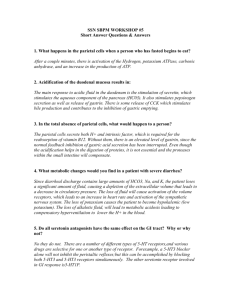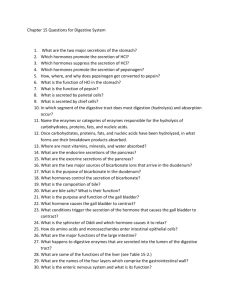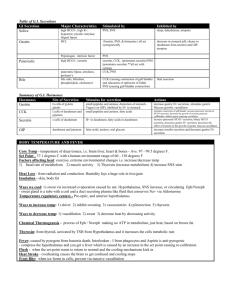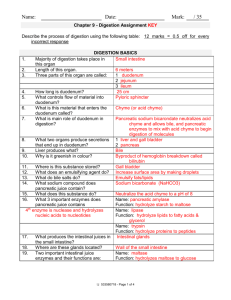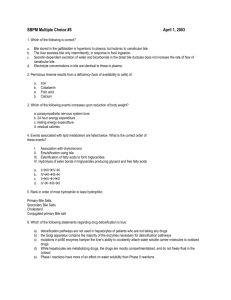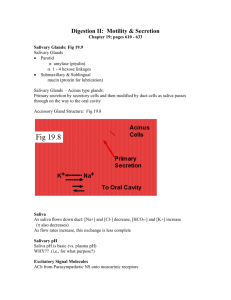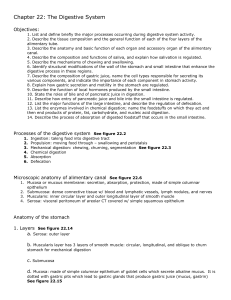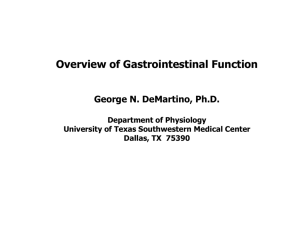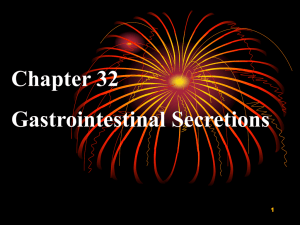GI Physiology MCQs
advertisement
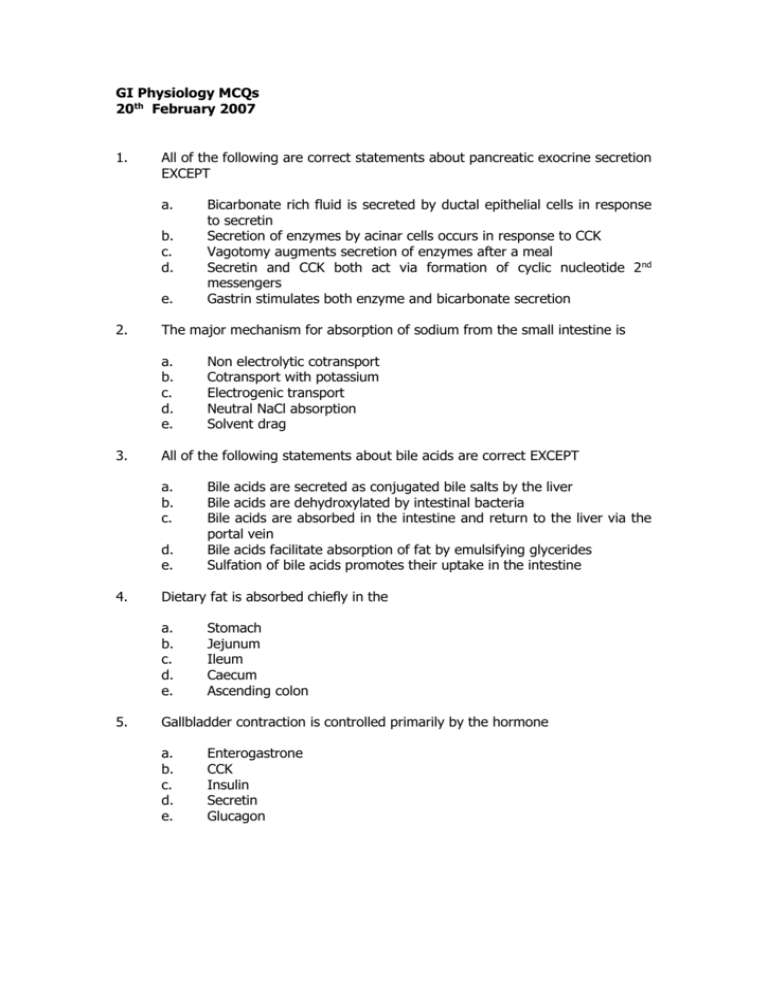
GI Physiology MCQs 20th February 2007 1. All of the following are correct statements about pancreatic exocrine secretion EXCEPT a. b. c. d. e. 2. The major mechanism for absorption of sodium from the small intestine is a. b. c. d. e. 3. d. e. Bile acids are secreted as conjugated bile salts by the liver Bile acids are dehydroxylated by intestinal bacteria Bile acids are absorbed in the intestine and return to the liver via the portal vein Bile acids facilitate absorption of fat by emulsifying glycerides Sulfation of bile acids promotes their uptake in the intestine Dietary fat is absorbed chiefly in the a. b. c. d. e. 5. Non electrolytic cotransport Cotransport with potassium Electrogenic transport Neutral NaCl absorption Solvent drag All of the following statements about bile acids are correct EXCEPT a. b. c. 4. Bicarbonate rich fluid is secreted by ductal epithelial cells in response to secretin Secretion of enzymes by acinar cells occurs in response to CCK Vagotomy augments secretion of enzymes after a meal Secretin and CCK both act via formation of cyclic nucleotide 2nd messengers Gastrin stimulates both enzyme and bicarbonate secretion Stomach Jejunum Ileum Caecum Ascending colon Gallbladder contraction is controlled primarily by the hormone a. b. c. d. e. Enterogastrone CCK Insulin Secretin Glucagon 6. All of the following statements about somatostatin are true EXCEPT a. b. c. d. e. 7. Compared with the resting state – during prolonged exercise the caloric needs of skeletal muscle are met by a. b. c. d. e. 8. d. e. Subsequent to its cleavage from proinsulin in the cell A response to both vagal and adrenergic stimulation The stimulator of release of pancreatic enzymes in response to glucose Inhibited by exercise None of the above Activation of hormone sensitive lipase in adipocytes a. b. c. d. e. 11. Reversible hydrophobic interactions Allosteric regulation Hydrogen bonding Formation of covalent linkages Coupling with an activity site Secretion of pancreatic polypeptide is a. b. c. 10. Release of free fatty acids from adipose tissue An increase in hepatic glycogenolysis An increase in gluconeogenesis in muscle Increased intestinal uptake of glucose and amino acids None of the above Binding of a peptide hormone to its receptor may involve all of the following EXCEPT a. b. c. d. e. 9. It inhibits gastrin secretion It is secreted by the hypothalamus It is secreted by pancreatic islet cells It is released following vagal blockade Its effects are prolonged Causes increased hydrolysis of cholesterol esters Is mediated by a cAMP dependent protein kinase Is prevented by cortisol Is stimulated by insulin Results in accumulation of monoglycerides and diglycerides in adipocytes All of the following statements about the uptake of triglycerides into adipose tissue from plasma lipoproteins are true EXCEPT a. b. c. d. e. It It It It It is regulated by the activity of lipoprotein lipase is decreased by catecholamines is increased by glucose is increased by insulin requires receptor mediated endocytosis 12. The islets of Langerhans are characterised by a. b. c. d. e. 13. Dietary fat, after being processes, is extruded from the mucosal cells of the GI tract into the lymphatic ducts in the form of a. b. c. d. e. 14. CO2 liberated by the interaction of HCO3- and H+ Diffusion from the blood Fermentation of undigested oligo saccharides by bacteria Swallowed atmospheric air None of the above Vitamins synthesised by intestinal bacteria and absorbed in significant quantities include a. b. c. d. e. 17. Carbohydrate in gastric contents Secretion of gastrin by antral G cells Distension of the duodenum Osmolarity of duodenal contents Acidity of chime entering the duodenum Gas within the colon is primarily derived from which one of the following sources a. b. c. d. e. 16. Monoglycerides Diglycerides Triglycerides Chylomicrons Free fatty acids The rate of gastric emptying is influenced by all of the following factors EXCEPT a. b. c. d. e. 15. Being more plentiful in the head of the pancreas than in the tail Constituting 20 – 30% of the weight of the pancreas Containing at least 6 distinct cell types Having a meagre blood supply Producing glucagon and insulin Vitamin B6 Vitamin K Thiamine Riboflavin Folic acid Which one of the following statements about the colon is correct a. b. c. d. e. Absorption of Na+ in the colon is under hormonal (aldosterone) control Bile acids enhance absorption of water from the colon Net absorption of HCO3- occurs in the colon Net absorption of K+ occurs in the colon The luminal potential in the colon is positive 18. Absorption of fat soluble vitamins requires a. b. c. d. e. 19. Contraction of the gallbladder is correctly described by which one of the following statements a. b. c. d. e. 20. CCK Gastrin Histamine Secretin None of the above Decrease pancreatic secretion of bicarbonate Increase secretion of gastric acid Decrease gastric emptying Increase contraction of the gallbladder Increase contraction of the sphincter of oddi In contrast to secondary oesophageal peristalsis, primary oesophageal peristalsis is characterised by which of the following statements a. b. c. d. e. 23. is inhibited by a fat rich meal is inhibited by the presence of amino acids in the duodenum is stimulated by atropine occurs in response to CCK occurs simultaneously with the contraction of the sphincter of oddi Acidification of the duodenum will a. b. c. d. e. 22. It It It It It Which of the following is a paracrine secretion a. b. c. d. e. 21. Intrinsic factor Chymotrypsin Pancreatic lipase Pancreatic amylase None of the above It does not involve relaxation of the lower oesophageal sphincter It involves contraction of oesophageal smooth muscle It is not influenced by the intrinsic nervous system It has an oropharyngeal phase None of the above The stimulation of release of pancreatic secretions normally involves all of the following EXCEPT a. b. c. d. e. Ach CCK Histamine Neural stimulation Secretion 24. Intestinal proteolysis is accomplished by all of the following EXCEPT a. b. c. d. e. 25. The concept that active transport is the mechanism for absorption of monosaccharides in the gut is supported by all of the following statements EXCEPT a. b. c. d. e. 26. d. e. Its pH is approximately 8.0 It has a high bicarbonate content Over 1000ml are secreted per day It contains cholesterol esterase Its secretion is primarily under neural control Mass movements (strong peristalsis) in the colon would be abolished by a. b. c. d. e. 29. A decrease in absorption of amino acids An increase in the water content of the faeces An increase in the concentration of bile acid in the enterohepatic circulation A decrease in the fat content of the faeces An increase in the absorption of iron All of the following statements concerning normal human pancreatic juice are true EXCEPT a. b. c. d. e. 28. Transport can be blocked by metabolic inhibitors Transport is selective for different sugars A maximum rate of transport exists for individual monosaccharides Competition exists among sugars for the carrier mechanism Transport can occur bidirectionally Removal of the terminal ileum will result in a. b. c. 27. Carboxypeptidase Chymotrypsin Elastase Pepsin Trypsin Vagotomy Extrinsic denervation Distension of the colon Destruction of Meissner’s plexus Destruction of Auerbach’s plexus Saliva has all the following constituents EXCEPT a. b. c. d. e. Bicarbonate Phosphate Chloride Glucose Lysozyme 30. Where are vitamins A, D and K absorbed a. b. c. d. e. 31. Regarding carbohydrate metabolism – which of the following statements is correct a. b. c. d. e. 32. is relatively higher in women than men falls about 10% during sleep is increased by tension falls about 40% during prolonged fasting increases in high and low environmental temperatures Calcium Luminal peptides and amino acids Secretin Epinephrine Increased vagal discharge Regarding GI hormones a. b. c. d. e. 35. It It It It It All of the following increase gastrin secretion EXCEPT a. b. c. d. e. 34. About 80% of energy supplies are stored in fat Most of the glycogen stores are in the liver Resting muscle utilises glucose for its metabolism At rest – the brain accounts for 40 – 50% of glucose utilised 5% of ingested glucose is promptly converted to fat Regarding basal metabolic rate – all are true EXCEPT a. b. c. d. e. 33. Stomach Proximal small bowel Terminal ileum Duodenum Ascending colon Luminal somatostatin inhibits gastrin secretion CCK secretion is increased by the presence in the duodenum of fatty acids containing more than 3 carbon atoms GIP is produced by the ileum Secretin increases the section of an enzyme rich pancreatic juice VIP causes contraction of intestinal smooth muscle Regarding the principal lipoproteins a. b. c. d. e. Chylomicrons originate in the liver IDLs are 40% phospholipids LDLs are 20nm in size HDLs are 25% protein VLDLs are 6% triglyceride GI Physiology MCQs 21st February 2006 Answers 1. C 32. A 2. D 33. C 3. E 34. A 4. B 35. C 5. B 6. E 7. B 8. D 9. B 10. B 11. E 12. E 13. D 14. A 15. C 16. E 17. A 18. C 19. D 20. C 21. C 22. D 23. C 24. D 25. E 26. B 27. E 28. E 29. D 30. B 31. A
